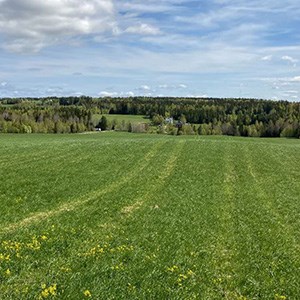Contact
David Parsons, Professor
Department of Crop Production Ecology, Crop production science
david.parsons@slu.se, 090-786 87 14

In this project, we will update satellite data with simple dynamic models for leys, to improve the forecasts of harvest time and nutrient content and create a useful decision support system (DSS).
Forage crops, typically mixed leys, occupy a dominant part of the agricultural landscape in Sweden. Farmers aim to maximize harvest yield while maintaining a high level of forage quality in order to achieve a high milk yield. However, deciding on harvest timing in order to achieve an optimal balance between yield and quality is challenging. A tool for mapping biomass, nitrogen (N) status and quality of forage will assist farmers with feed budgeting, harvest logistics, efficient use of fertilizer, and eventually, result in an economically and environmentally more sustainable system. Open-access satellite data, combined with simple crop models, supply good opportunities to estimate various forage crop properties.
The project aims to develop a DSS for forage N status assessment and harvest time determination based on satellite data processing at field level. The specific objectives are:
This project aims to enable farmers to harvest more forage at the desired quality, through appropriate nitrogen fertilization and the ability to make better informed harvesting decisions. This can increase milk production and result in improved profitability for farmers. It is also expected that the risks of nitrogen losses will be reduced with higher N use efficiency and more efficient forage production. Farmers will be able to see whether their current N fertilization regime is functioning well, and whether there is variability in the field that may justify a variable N rate approach. The DSS tool developed in this project will be similar to the decision-making system “CropSat” which is available online and free to use (www.cropsat.se).
The project is funded by the Swedish Farmers’ Foundation for Agricultural Research (Stiftelsen Lantbruksforskning; SLF)
Junxiang Peng, Postdoctor
Department of Crop Production Ecology, Crop production science
junxiang.peng@slu.se, +46907868116, +46761358793
Julianne Oliveira, Researcher
Department of Crop Production Ecology, Crop production science
julianne.oliveira@slu.se, +46907868724, +46767637129
Johan Martinsson, Manager
Innovation & business development, Dataväxt AB
jm@datavaxt.se
David Parsons, Professor
Department of Crop Production Ecology, Crop production science
david.parsons@slu.se, +46907868714, +46730893445
David Parsons, Professor
Department of Crop Production Ecology, Crop production science
david.parsons@slu.se, 090-786 87 14